Apple's MacBook Pro: Using it as a Mac and a PC
by Anand Lal Shimpi on April 13, 2006 12:00 AM EST- Posted in
- Mac
With the MacBook Pro Apple introduced its MagSafe power connector, a magnetic power connector that's designed to easily break away if you accidentally step on the cord or pull it too far instead of taking the notebook down with it. The idea makes a lot of sense, and the connector is significantly smaller than its predecessor, but there are many cases where it can get annoying. Although the MagSafe connector remains attached most of the time, the minute you put more strain than normal on the power cable you can expect it to break away. While normally this behavior would be what you want, it's generally not what you expect if you're used to conventional power connectors. I'm convinced that the MagSafe approach is safer as the chances of you breaking your power connector or even worse, your laptop, are far diminished but it takes some getting used to. If you're used to using your notebook at the very limits of its power cable's length, you'll have to change your ways as the MagSafe connector won't allow it.
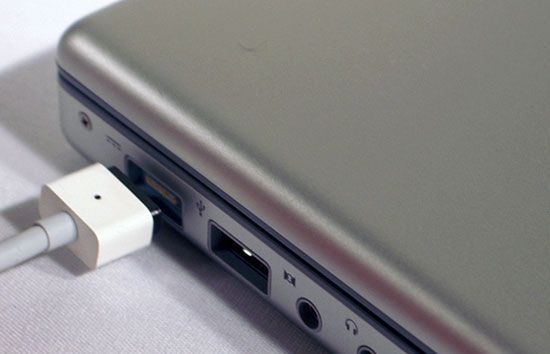
MagSafe
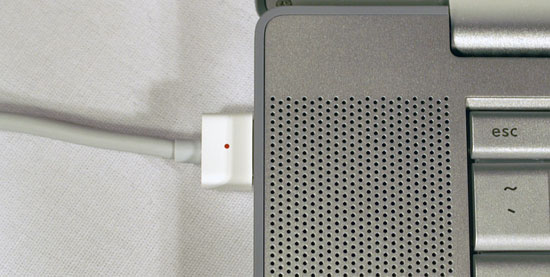
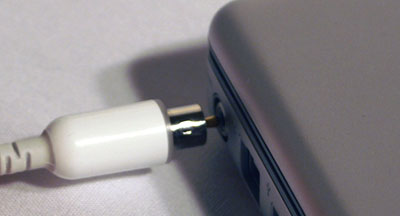
The PowerBook G4's old power connector
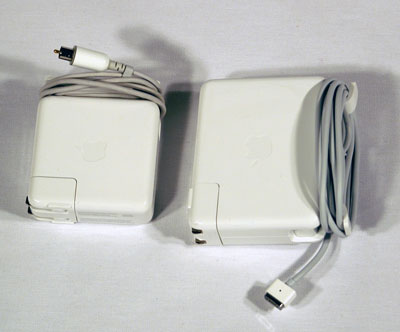
PowerBook G4 power adapter (left) vs. MacBook Pro adapter (right)
The caps lock LED is now a much brighter green compared to its predecessor's yellow-green color. The MagSafe power connector also features the same green LED, and when charging the LED turns a similarly bright orange. The size of the light on the power connector has been reduced, though, which means that the MacBook Pro won't illuminate a dark hotel room nearly as much as the old PowerBooks did when charging while you sleep. Having spent many trips covering my PowerBook with a pillow while it charged, the change is welcome.

The MacBook Pro's keyboard is identical to its predecessors, which overall isn't a bad thing. The PowerBook G4's keyboard ended up being one of my all time favorites, second only to ThinkPad keyboards which continue to be my top choice for anyone who writes a lot. Being that it uses the same keyboard as before, the MacBook Pro doesn't feature any dedicated page up/page down keys nor any dedicated home/end keys (they are shared with the arrow keys). I would assume that a solid portion of Apple's customers may be folks who happen to be writers, in which case it would make sense for Apple to invest in an updated keyboard layout that accommodates keys frequently used by them.
My only other complaint about the keyboard is actually a complaint I have about virtually all notebook keyboards - that the fn key does not need to be in the lower left corner of the notebook. There are less frequently used areas on the keyboard to stick that key and for some reason it always ends up being around the keys I use fairly frequently (left ctrl, left option and left command). This isn't really any Apple-specific complaint, but rather something that has bothered me about every notebook keyboard I've used.
The trackpad on the MacBook Pro is huge; it's one of the first things I noticed after lifting the display lid. Other than the "why-not?" factor, it seems that Apple made it so big to better accommodate the scrolling functionality that's supported by it. Using two fingers on the trackpad you can now scroll horizontally or vertically. The process is actually extremely natural and far better than other systems I've used where only particular parts of the trackpad are reserved for scrolling. Just as you would guess, you place two fingers on the trackpad and move them in the direction you wish to scroll. Your cursor disappears and you begin to scroll; while it's not as natural as using a scroll wheel on a mouse, it's pretty darn close.
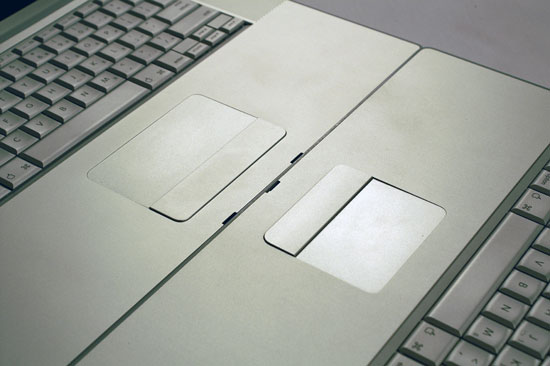
The MacBook Pro, like the Intel based iMac Core Duo, features an integrated iSight camera and Front Row support, both of which I've already looked at. The implementation is no different on the MacBook Pro, and the integrated iSight camera is arguably even more useful on a notebook where you're less likely to have an external USB camera just laying around.










52 Comments
View All Comments
nels0360 - Thursday, April 13, 2006 - link
The hardware issue mentioned have been or are being fixed.Apple has release silent revisions of the MacBook Pro. It is well documented on other sites such as Macrumors.com
In fact, I believe Apple will give you a new revision if you complain about one of these problems.
plinden - Thursday, April 13, 2006 - link
I know they are different benchmarks, but over at http://www.macworld.com/2006/04/firstlooks/xpbench...">MacWorld, they found that the MacBook Pro was faster at running Windows than three Windows-only PCs.I'm not going to editorialize here, just bringing this to your attention.
ss284 - Friday, April 14, 2006 - link
Which pretty much drops macworld's benchmark credibility to zero. Actually, their credibility was already really low so its no big deal.ss284 - Friday, April 14, 2006 - link
Unless the benchmark was how fast it could burn a hole in your pants and sterilize your important parts.jbb132 - Thursday, April 13, 2006 - link
Sadly, even the most recent MacBook Pro's continue to suffer from the hardware problems you noticed. I've now had two units with the "whine," particularly when the laptop is running on battery power. The only way to stop it is to turn photobooth on and leave it on. Various hacks (magicnoisekiller in particular) help but really...Pirks - Thursday, April 13, 2006 - link
Hey Anand!Thanks for an interesting review! Now, what was the video source codec and resolution in your H.264 encoding test? I've got a Mac zealot here saying he's got only 2 frames per second in similar H.264 encoding task. He also has Mac OS X 10.4.6 and Quicktime Pro 7.0.4. I wonder is you used source with resolution like 160 by 120 for that test??
To other readers: take with a grain of salt Anand's view on running multiple apps simultaneously in XP. He says something like "uh oh we can't run multiple apps all the time on win coz win can't manage its RAM blah blah", but in fact if you disable XP swap AND if you stick 2 or 3 gigs or RAM in your mobo you'll get my experience of running dozens of apps open at the same time and even some games while at it (DOOM 3 + Matlab + Maya 7 + other little apps like VDub open at the same time is a no brainer on my XP). Stick 4 gigs and open even more, without loss of performance. In fact if you wanna get Mac OS X experience, just stuff your mobo with RAM and turn off swap, that's it, no need to spend $$$ on Mac to get this "experience" :-))
One last minor correction - Anand tells you "anything more than 2GB of RAM on your PC is useless" but he does not know about /3GB switch (google up "/3GB switch") which again allowed me to run Matlab with THREE gigs or RAM consumed, not two.
Just my 2 cents to debunk some myths that Mac zealots love to spread ;) Don't get caught in that stuff, read docs/mans and be smart.
Anand Lal Shimpi - Friday, April 14, 2006 - link
The source for my H.264 test was the Hoodwinked trailer from Apple's Quicktime trailers site.My comments about memory usage and Windows XP have nothing to do with the /3GB switch. The point I was trying to make is that Windows XP does not do a good job of caching to reduce disk accesses. Microsoft itself has admitted that there's lots of room for improvement, which is why you hear about all of the caching improvements that will be introduced in Vista.
Take care,
Anand
kleinwl - Thursday, April 13, 2006 - link
BTW: if you don't think that anandtech knows about the /3GB switch you certainly haven't been here very long.Pirks - Thursday, April 13, 2006 - link
Did Anand ever mention this switch in any of his reviews? Or anyone else besides him from AT staff? I've never seen it before. How about you? Would you provide me with a link or some other proof? I'd love to be corrected here, since AT guys should know about it, and I wish I were wrong stating the opposite, especially about Anand himself.As for the stability - I run Matlab with 3GB consumed routinely, it also loads some Maya 7 stuff internally via my own DLL and there's another Maya 7 hanging around to check results from Matlab quickly, and I never saw a slightest glitch. Of course YMMV but I heard too much "omg windoze is 2GB limited and mac is TrUe 64-bit WoNdEr" and I've got some experience with Matlab on both Mac OS X (no 64-bit matlab there) and WinXP (now this is true 64-bit product) to let Anand repeat that kind of sh.t. Mac guys are ok to say that, they live like this, so no big deal but not Anand please :-) So let's just say "please Anand be a bit more correct in some places and don't sound like a dumb Mac user", saying windows can't properly run a lot of apps at once and stuff like that.
Speaking of Vista I've read somewhere on MSDN that a lot of XP 64 code is in there so it _should_ be as robust as XP 64 with regard to RAM handling. I'm sure after SP1 or SP2 it'll be absolutely rock solid :-)
kleinwl - Thursday, April 13, 2006 - link
I've used the /3GB switch as well... however it can (and does) degrade the stability of your system (running fluent (a CFD program) on XP SP2). I wouldn't run around recommending the normal use of the /3GB switch. Some programs don't even support it (ie. Catia V15). Ultimately we upgraded to XP x64 (which came with it's own headachs).2.5GB seems to be the most that XP SP2 can really handle well.. everything else is a waste. OS X just does a better job handing large amounts of ram and not "losing" it with time.
I am interested is seeing how VISTA will perform and if will be as good as OSX or XP x64 with ram... or something quite better (or worse).